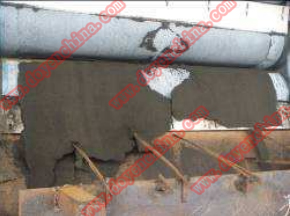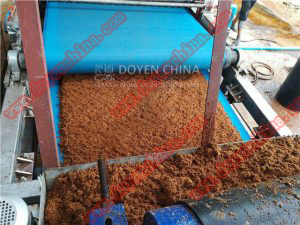

Tel:
+86-757-8633-0278
Email:doyen@doyenchina.com
Fax:+86-757-86287390
Address:Room 201, Building No. 24, Yicui Rose Garden, No. 2, Jihua 7 Road, Chancheng District, Foshan City, Guangdong Province, China 528000.
With the development of modern industry, mineral resources are increasingly depleted, and the ore mined is already facing the situation of “poor, fine, and miscellaneous”. For this reason, people have to grind the ore to be finer, and the “fine, mud, sticky” The material undergoes solid-liquid separation. Nowadays, in addition to high requirements for energy saving and environmental protection, enterprises have put forward higher and broader requirements for solid-liquid separation technology and equipment. In response to the social needs of mineral processing, metallurgy, petroleum, coal, chemical, food, environmental protection and other industries, the application of solid-liquid separation technology and equipment has been driven, and the breadth and depth of its application fields are still expanding.
The reason why the filter press can flourish and be widely used in various industries, its big advantage is the positive pressure, high pressure
Strong dehydration, the pressure difference is much larger than that of the traditional vacuum filter, so the filter cake has low water content, less energy consumption, less metal loss, and the filtrate is clear and transparent. As early as more than ten years ago, experts pointed out that the filter press is the only one among all industrial filters at present-it can ensure that the moisture content of the filter cake is below 10%, and it can be an excellent equipment without flocculants.
As far as the filter plate form is concerned, the filter press can be divided into a box type and a plate and frame type; in terms of the placement of the filter plate, there are vertical and horizontal types;
The material of the filter plate is different, including plastic, rubber, cast iron, cast steel, carbon steel, and stainless steel; whether the filter plate is equipped with rubber extrusion membrane, there are squeeze dehydration and non-squeeze dehydration points; the filter plate configuration The number of filter cloth faces is different, and there is a single side off

The difference between water and double-sided dehydration and so on. But no matter what kind of filter press, its working principle is firstly positive pressure dehydration, also called slurry dehydration, that is, a certain number of filter plates are tightly arranged in a row under the action of strong mechanical force, the surface of the filter plate and the filter plate
A filter chamber is formed between the surfaces. The filter material is sent into the filter chamber under strong positive pressure. The solid part of the filter material entering the filter chamber is intercepted by the filter medium (such as filter cloth) to form a filter cake, and the liquid part passes through the filter medium. The filter chamber is discharged to achieve the purpose of solid-liquid separation. As the positive pressure increases, the solid-liquid separation becomes more thorough, but in terms of energy and cost, too high a positive pressure is not cost-effective. After the pulp is dewatered, a filter press equipped with a rubber extrusion membrane, the compressed medium (such as air, water) enters the back of the extrusion membrane to push the extrusion membrane to further dehydrate the extruded filter cake, which is called extrusion dehydration. After pulping dehydration or squeezing dehydration, compressed air enters one side of the filter cake to penetrate the filter cake, carrying liquid water from the other side of the filter cake through the filter cloth and out of the filter chamber for dehydration, which is called wind-blown dehydration. If there are filter cloths on both sides of the filter chamber, the liquid part can evenly penetrate the filter cloths on both sides of the filter chamber and drain out of the filter chamber. After the dehydration is completed, the mechanical pressing force of the filter plate is released, the filter plate is gradually pulled apart by a single piece, and the filter chamber is opened to unload the cake as a main work cycle. According to the different properties of the filtered materials, the filter press can be set separately for pulp dewatering, squeezing dewatering, wind-blown dewatering or single or double-sided dewatering. The purpose is to minimize the moisture content of the filter cake. ―At present, Shuikoushan filter presses are divided into two categories: box type and plate and frame type. There are three series of carbon steel type, plastic type and stainless steel type.

For solid-liquid separation in various industries. The Shuikoushan filter press is designed, manufactured, promoted and applied by the filter press manufacturer of Hunan Shuikoushan Nonferrous Metals Group Co., Ltd. The application effects of the filter press are as follows:-1. Application in concentrate dewatering
Use: ― 1. Application in general concentrate dehydration: XYZ—DZ20×45/800×1000/0.8 filter press, the application effect in general concentrate dehydration is as follows:
Material: copper concentrate, lead concentrate, zinc concentrate, sulfur concentrate
Mine-200 mesh 85~90% 95% 85% 80% high working wind pressure 7MPa7MPa7MPa7MPa—moisture <14%7%8.5%8.5%tF/unit h4108.592, application in the dehydration of difficult-to-filter concentrates:
-200 mesh content accounted for 95~98%, high mud content, high alkali content and 3# flocculant, copper concentrate with silicate forming silica gel in the concentrate, the filter press dehydration effect is as follows:
Equipment model high working wind pressure moisture <t dry volume/set
hXYZ—SJ60×28/1000×1000 / 0.87Mpa14% 10.8XYZ—SZ45×28 / 800×1000 / 0.8U5MPa15~7%4.2~5
The lead grade of the raw ore is 7%, the sludge content is greater than 37%, the lead grade of the concentrate is 30%, and the content of -200 mesh is 98%. The thickening pool adds lime as a flocculant, and the underflow concentration is greater than 45% of the lead oxide concentrate. as follows:
Equipment model high working wind pressure moisture <t thousand/unit hXYZ—
SZ45×28/800×1000 / 0.8U5Mpa24%2. Application in non-ferrous smelting:
XYZ—SZ60×25/1000×1000/0.8U filter press has the following application effects in hydrometallurgy:
1. Dehydration of reduction residue: unreacted ZnS concentrate and monomer sulfur, filtration temperature 80~90℃, acidity <5%H2SO4, slurry-to-solid ratio 4~6:1, slurry ratio 1.6~1.8, after filtration Slag water content 10%~
12%. ―2. Dehydration of high-leaching residue: medium leaching→low acid leaching→high acid leaching leaching slag, the pulp proportion is 1.6~1.7, the filtration temperature is 65℃, the water content of the slag after filtration is 21%~22%, and the slag contains 8.525% of total zinc. Slag water-soluble zinc
4.793%. ―—3. Dewatering of iron slag: it is intermediate leaching and then spraying iron slag, the proportion of ore slurry is 1.65, the filtering temperature is 75℃, the water content of the slag after filtration is 25.1%, the slag contains 20% of total zinc, the slag contains 5.46% of soluble zinc, and Iron is 28.7%, and a working cycle of 26min produces 1486kg of wet slag.
4. Dehydration of lead and silver slag: for medium leaching and adding high temperature and high acid to leaching the slag, the liquid contains 80~100g/l of acid, the filtration temperature is 60~90°C, after filtration, the residue contains 22.85% water, and the residue contains total zinc.
8010%, 53.74 tons of dry residue can be produced per day.
5. Dehydration of arsenic and iron slag: it is the second intermediate leaching slag. After the first intermediate leaching, 3# flocculant is added to the slag slurry, the slag contains 8~10% silicon, the filtration temperature is 65~75C, and the liquid contains 120g zinc sulfate
/L, the proportion of the powder pile is 1.8, the slag after filtering contains 32% of water, the slag contains 16% of total zinc, and the slag contains 5.5% of zinc. —XS—S40×28/ 840×840/ 0.8U filter press, treat the male mud in the wet-process electric lead, the slag contains acid water
Moisture content is less than 35%, and 900kg wet residue is produced each time. —3. Application in the coal industry: XYZ-DZ22×28/800×1000/0.8 filter press is used to dehydrate the flotation clean coal with a content of -200 mesh accounting for 94.6%, and the water content of the filter cake is 24 to 28% The processing capacity is 0.28~-0.35t/m2-h; the flotation clean coal with 79% content of -200 mesh is dehydrated, the water content of the filter cake is 17-22%, and the processing capacity is 0.3~-O.4t/m2h. 4. In wastewater treatment
Application: —100m3/h smelting sewage treatment station, using three XZ—DZ60×30/100×1000/0.8 filter presses to process smelting sewage with a solid content of 2~3%, and the slag water content is 62~68% , Dry residue output
200~350kg/unith, the water quality is as follows: (see the following table) It can be seen from the above application effects that filter presses are used for filtering fine, muddy and viscous materials in various industries, and filter presses are excellent solid-liquid separation equipment However, it is developed and widely used, and the development prospects will be broader. The indicator unit SS Zn Cd Pb Cu As F emission standard mg L 200 5.0 1.01.01.00.510 Actual emission value mg L829.34 0.08 0.55 0.12
0.05 7.42 Removal rate% 93.5 99.4 98.8 93.695.3 98.9 21.4
Doyen specializes in providing belt press equipment for the Southeast Asian market. Welcome to visit our workshop and formulate a more scientific plan based on the actual situation of your company. Welcome to visit joyce@doyenchina.com or visit https://www.doyenchina.com.
Feb-16-2021
admin

 +86-757-8633-0278
+86-757-8633-0278 doyen@doyenchina.com
doyen@doyenchina.com Sitemap
Sitemap